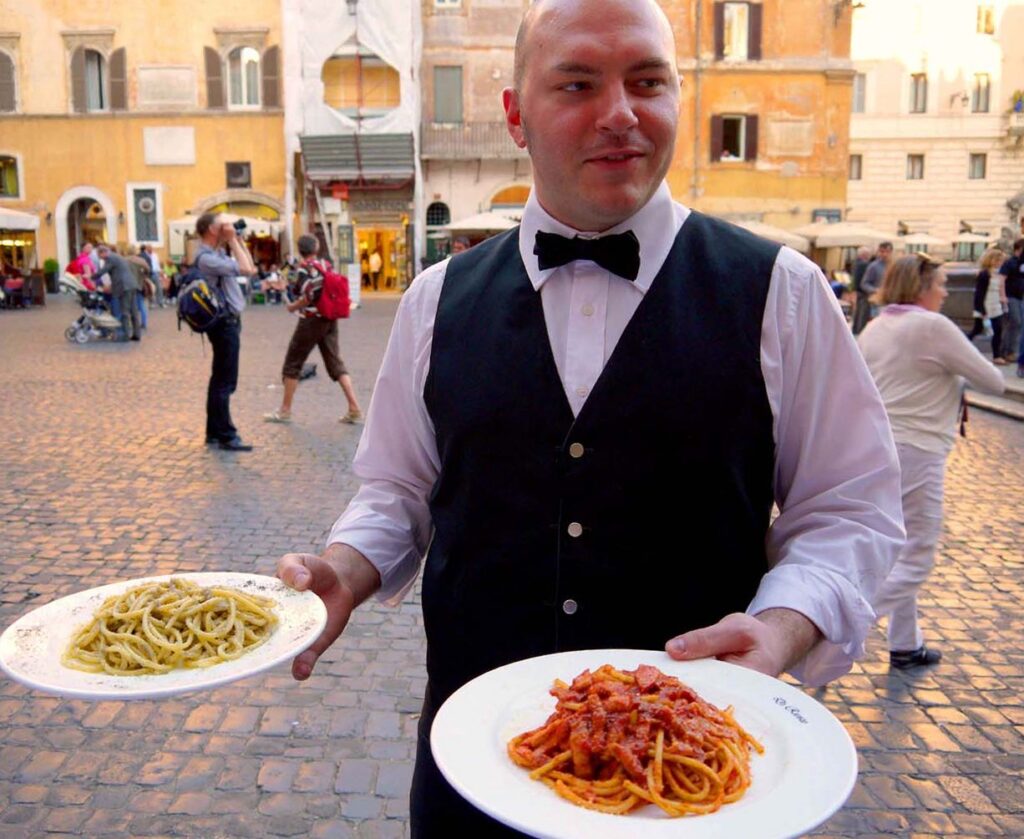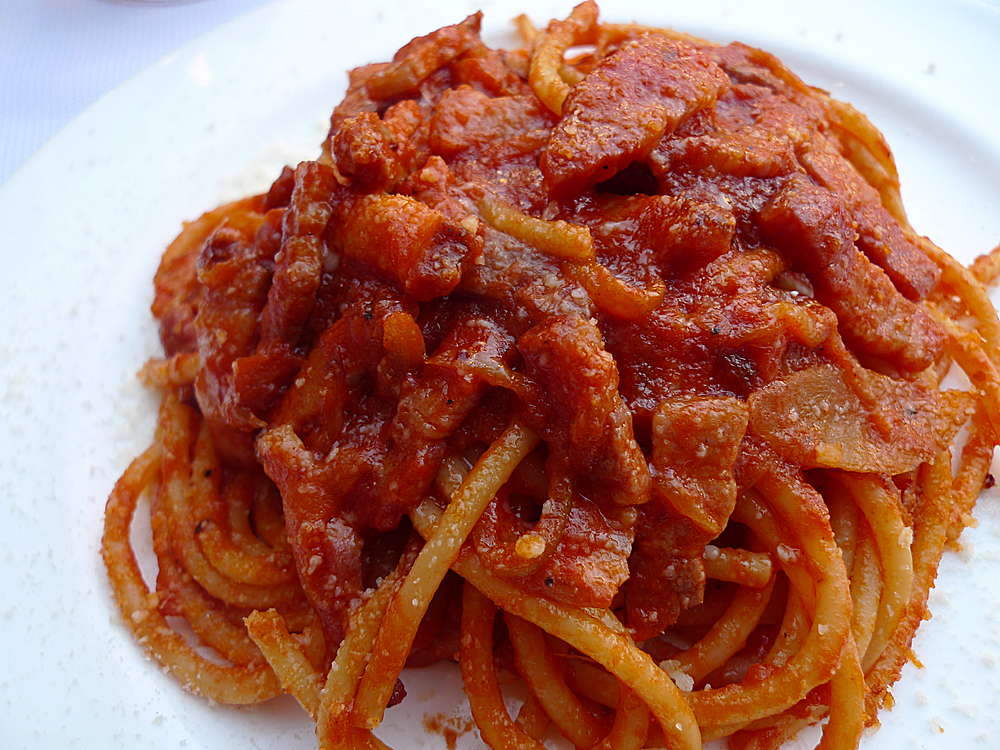
Watching Stanley Tucci sample the classic pastas of Rome was a déjà vu experience for us—especially when he showed up at a restaurant on Piazza della Rotondo to launch the episode. We had a similar experience just a few years ago, also in front of the Pantheon at Ristorante di Rienzo. It’s now Bistrot al Pantheon di Rienzo (Salita de’ Crescenzi 3, 06-687-7404, www.bistrotalpantheon.it) and in one incarnation or another dates back to 1952. Thanks to an introduction by an Italian chef friend, the daughter of the founder invited us to come back at dinner time so the chef could show us how to prepare some classic Roman pasta dishes.
When we returned around 6 p.m., chef Alessandro Sillani and his assistant Tsatsu Nicholas Awuku weren’t even breaking a sweat sending out dishes to early diners. They demonstrated two of the simplest and most delicious of Roman preparations, cacio e pepe (or cheese and pepper), and amatriciana (tomato and lardons of cured pork cheek). They made both with the thick tubular pasta with a tiny hole in the middle called bucatini. In fact, the restaurant uses Barilla No. 9 bucatini, widely available in the U.S. Like chefs in many restaurants that serve a lot of pasta, Di Rienzo had converted deep-fry vats to boil salted water. The chefs could simply toss the portions of dried pasta into the fryer baskets, lifting and draining in a single motion when the pasta was al dente.
Simplicity the keynote of cheese and pepper
Awuku handled the cacio e pepe. He melted a gob of butter in a skillet, then mixed grated Pecorino Romano cheese and black pepper together in a stainless steel bowl. He poured in the melted butter, mixed well and checked the consistency. When it seemed a little dry, he added a drizzle of olive oil. Once the pasta was al dente, he added the hot pasta to the cheese mixture and tossed to coat. He twisted the unruly and springy pasta very tightly to form a nest, transferred it to a plate and then sprinkled on more cheese. Simple and magnifico!
Now for a little red sauce…
While Awuku was teaching us cacio e pepe, Sillani demonstrated the equally popular and almost as simple sauce for bucatini all’amatriciana. Tradition holds that this sugo (sauce) originated in Amatrice, a town in the mountains of Lazio on the border with Abruzzo. Many families from the region settled in Rome, adding this dish to the capital’s own cuisine.
Sillani heated olive oil in a large frying pan, sautéed sliced onion until it was soft, and then added a thick pinch of hot pepper flakes and a handful of diced guanciale—cured pork cheek. He kept cooking until the onion was golden and the guanciale well cooked. At this stage, Sillani tossed a serving of bucatini into the salt-water converted fryer, then returned to making the sauce.
The rest of the sauce went swiftly: He ladled in pureed tomatoes and kept stirring the sauce over high heat until the bucatini was cooked (about 9 minutes), then added the drained pasta to the sauce.
It could not have been simpler or more delicious—and it’s just as easy to make at home.
BUCATINI CACIO E PEPE
serves four as a pasta course or two as a main course.
INGREDIENTS

1 lb. bucatini
1 cup freshly grated Pecorino Romano cheese
1 tablespoon freshly ground black pepper
4 tablespoons butter
olive oil as needed
extra Pecorino Romano to taste
DIRECTIONS
Cook pasta about 10 minutes in salted water.
While pasta is cooking, combine black pepper and grated cheese. Melt butter and add to cheese mixture, stirring well to combine. Add olive oil as needed to create a thick cheese sauce.
When pasta is cooked firm, drain and add to bowl of cheese sauce. Toss to coat.
Place on plate with large fork, twisting mixture tightly. Add extra cheese to taste.
BUCATINI ALL’AMATRICIANA
serves four as a pasta course or two as a main course.
INGREDIENTS

3 tablespoons olive oil
1 medium onion, thinly sliced
1/2 teaspoon hot pepper flakes
3 oz. guanciale (or pancetta), cut in 1/4” dice
1 lb. bucatini
3 cups pureed (”ground”) tomatoes
freshly grated Pecorino Romano cheese
DIRECTIONS
Sauté onion in olive oil in large frying pan. When onion is soft, add pepper flakes and guanciale and sauté over high heat until onions are golden and guanciale begins to brown.
Add pasta to boiling water.
Add tomatoes to frying pan and continue heating over high flame.
When pasta is cooked firm (about 9 minutes), drain and add to sauce in frying pan. Toss to coat.
Twist mixture tightly with a large fork and transfer to serving plates. Serve with Pecorino Romano cheese.
